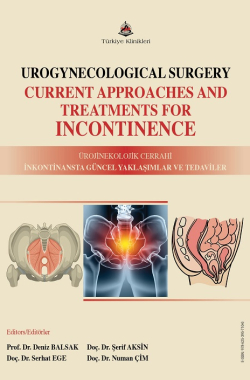PELVIC FLOOR REHABILITATION
Narin Ece Rol
Zeynep Kamı̇ l Women and Chı̇ ldren Dı̇ seases Tranı̇ ng and Research Hospital, Department of Gyneclogy and Obstetric, İstanbul, Türkiye
Rol NE. Pelvic Floor Rehabilitation. In: Balsak D, Çim N, Ege S editors. Urogynecological Surgery Current Approaches and Treatments for Incontinence. 1st ed. Ankara: Türkiye Klinikleri; 2025. p.313-318.
ABSTRACT
The pelvic floor is a complex structure composed of muscles and connective tissues that plays a fundamental role in maintaining the healthy function of the female urogenital and gastrointestinal systems. Physiological events such as pregnancy, childbirth, and menopause can lead to weakening of these muscles, predisposing women to pelvic floor dysfunctions. Such dysfunctions commonly manifest as urinary incontinence, pelvic organ prolapse, or defecation difficulties, significantly reducing patients’ quality of life. Conditions like pelvic organ prolapse and stress urinary incontinence often reach a severity that necessitates surgical intervention. However, while surgery restores anatomical integrity, maintaining long-term functional continuity requires supportive rehabilitation.
Postoperative pelvic floor rehabilitation should be planned in alignment with the tissue healing process. Protective measures and gentle awareness exercises in the early phase help control edema and inflammation, while structured muscle strengthening programs are gradually introduced in later stages. Kegel exercises, isometric contractions, and breathing-coordinated pelvic activations are among the commonly used methods. The type of surgery, the use of synthetic materials, and patient-specific comorbidities necessitate individualized protocols. For example, the presence of mesh or advanced age may require modifications in rehabilitation progression.
Effective strengthening of the pelvic floor muscles is also a cornerstone of conservative management. Targeting the correct muscle groups, supported by biofeedback and, when necessary, electrical stimulation, enhances motor control. Biofeedback educates patients on proper muscle contractions, while electrical stimulation can be beneficial for those unable to generate voluntary contractions. Studies show that integrating these technologies with conventional exercises improves recovery speed and quality.
In conclusion, pelvic floor rehabilitation is an indispensable component of both surgical and conservative treatments. Multidisciplinary team support, patient education, and regular follow-up are key factors that enhance treatment outcomes. With the advancement of sensor-based feedback systems and digital platforms, patient adherence has improved, adding a new dimension to clinical practice. Keeping knowledge up to date in this field is essential for women’s health professionals to ensure sustained treatment success.
Keywords: Urinary incontinence; Pelvic floor disorders; Pelvic organ prolapse; Postoperative care; Interdisciplinary communication
Kaynak Göster
Referanslar
- Demirtürk F. Çeşitli Yaş Dönemlerinde Pelvik Taban Kas Kuvvetini Etkileyen Faktörlerin İncelenmesi. Hacettepe Üniversitesi Sağlık Bilimleri Enstitüsü. Doktora Tezi, Ankara. 2006.
- Eryılmaz HY. Pelvik Bozukluklar. Şirin A, Kavlak O (Eds). Kadın Sağlığı Kitabı, Bedray Yayıncılık, Birinci baskı, ISBN:978-605-5989-07-1. s:501-515, İzmir 2008.
- Borello-France DF, Zyczynski HM, Downey PA, Rause CR, Wister JA. Effect of pelvic-floor muscle exercise position on continence and quality-of-life outcomes in women with stress urinary incontinence. Phys Ther. 2006 Jul;86(7):974-86. [Crossref] [PubMed]
- Dumoulin C, Cacciari LP, Hay-Smith EJC. Pelvic floor muscle training versus no treatment, or inactive control treatments, for urinary incontinence in women. Cochrane Database Syst Rev. 2018;10(10):CD005654. [Crossref] [PubMed] [PMC]
- Good MM, Solomon ER. Pelvic Floor Disorders. Obstet Gynecol Clin North Am. 2019;46(3):527-540. [Crossref] [PubMed]
- Bø K, Hilde G. Does it work in the long term?-A systematic review on pelvic floor muscle training for female stress urinary incontinence. Neurourol Urodyn. 2013;32(3):215-23. [Crossref] [PubMed]
- Hay-Smith EJC, Herderschee R, Dumoulin C, Herbison GP. Comparisons of approaches to pelvic floor muscle training for urinary incontinence in women. Cochrane Database Syst Rev. 2011;12:CD009508. [Crossref]
- Nyström E, Sjöström M, Stenlund H, Samuelsson E. ICIQ instruments measure clinically relevant improvements after PFMT. Neurourol Urodyn. 2015;34(8):747-51. [Crossref] [PubMed]
- Hagen S, Stark D. Conservative prevention and management of POP in women. Cochrane Database Syst Rev. 2011;(12):CD003882. [Crossref] [PubMed]
- de Carvalho MLAS, Bezerra LO, Oliveira JMP, Oliveira MCE, Micussi MTABC. Pelvic floor muscle training in women with urinary incontinence and pelvic organ prolapse: A protocol study. PLoS One. 2024;19(8):e0308701. Published 2024 Aug 16. [Crossref] [PubMed] [PMC]
- Bernard S, Bø K, Hélène D. Impact of postoperative physiotherapy after pelvic organ prolapse surgery: a randomized controlled trial. Int Urogynecol J. 2020;31(4):737-45.
- Wiegersma M, Panman CM, Kollen BJ, Berger MY, Lisman-Van Leeuwen Y, Dekker JH. Effect of pelvic floor muscle training compared with watchful waiting in older women with symptomatic mild pelvic organ prolapse: randomised controlled trial in primary care. BMJ. 2014 Dec 22;349:g7378. [Crossref] [PubMed] [PMC]
- Kegel AH. Progressive resistance exercise in the functional restoration of the perineal muscles. Am J Obstet Gynecol. 1948;56(2):238-48. [Crossref] [PubMed]
- Bump RC, Hurt WG, Fantl JA, Wyman JF. Assessment of Kegel exercise performance after brief verbal instruction. Am J Obstet Gynecol. 1991;165(2):322-7. [Crossref] [PubMed]
- Laycock J, Jerwood D. Pelvic floor muscle assessment: the PERFECT scheme. Physiotherapy. 2001;87(12):631-42. [Crossref]
- Dumoulin C, Alewijnse D, Bo K, et al. Pelvic-Floor-Muscle Training Adherence: Tools, Measurements and Strategies-2011 ICS State-of-the-Science Seminar Research Paper II of IV. Neurourol Urodyn. 2015;34(7):615-621. [Crossref] [PubMed]
- Hegde A, Aguilar VC, Davila GW. PFMT before and after pelvic reconstructive surgery. Int Urogynecol J. 2011;22(7):893-905.
- Frawley HC, Sherburn M, Bø K. Effect of physical therapy on PF muscle strength after surgery. Phys Ther. 2012;92(4):494-509.
- Laycock J, Haslam J. Biofeedback and pelvic floor re-education. Springer; 2007.
- Burgio KL, Goode PS, Locher JL, et al. Behavioral training with and without biofeedback for urge incontinence in older women: a randomized controlled trial. JAMA. 2002;288(18):2293-9. [Crossref] [PubMed]
- Sand PK, Richardson DA, Staskin DR, et al. Pelvic floor electrical stimulation in the treatment of genuine stress incontinence: a multicenter, placebo-controlled trial. Am J Obstet Gynecol. 1995;173(1):72-79. [Crossref] [PubMed]
- Bø K, Mørkved S. The role of physiotherapists in women's health: Pelvic floor muscle training. Neurourol Urodyn. 2013;32(3):223-9.

